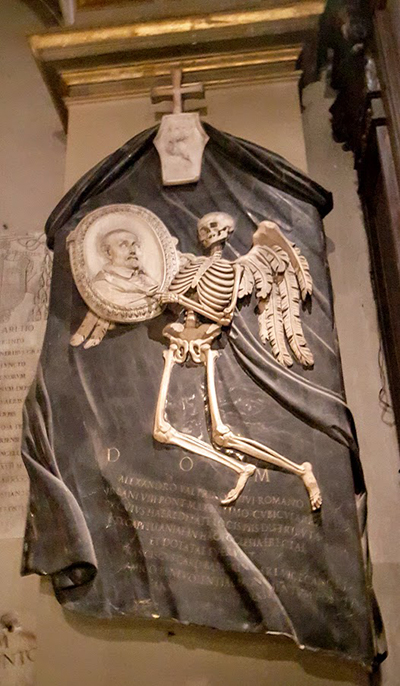The Memorial to Alessandro Valtrini was designed by Gian Lorenzo Bernini and executed in the same year by his workshop. Gian Lorenzo and his team completed the memorial in 1639 according to the inscriptions on the bust.
It is a funerary monument designed to honour Valtrini a notable figure at the time. He was a wealthy man revered by society, and his influence extended far and wide. Three churches Valtrini supported created monuments to honour him. The Bernini version is the first monument while the other two comprise of one located in Santa Maria Sopra Minerva, and another in II Gesù. Memorial to Alessandro Valtrini by Gian Lorenzo Bernini is strongly affiliated with the Memorial to Ippolito Merenda designed by the same artist and completed by his workshop.
In this portrait, Bernini portrays a low relief, and three-quarter view of Alessandro Valtrini bounded by an ornate oval frame. He shows Alessandro Valtrini facing a winged skeleton that stares in the front. The skeleton is holding the portrait in his right hand, and its left hand’s index finger points towards the frame.
In addition, an inscription in the portrait appears to flow with the lower part of the cloth where the skeleton’s feet overlaps. The cross attached to the coat-of-arms support the motionless upper section of the drapery located at the top centre of the memorial. Bernini's aim in this portrait was to personify death as typical of the art pieces of the time. The 16th and 17th-century societies were preoccupied with death, and Bernini hoped that people would understand this portrait from that viewpoint.
The portrait was designed using the Baroque style. This is indicated by the presence of figurative elements in this bust. In addition, the design tries to incorporate aspects of naturalism in the bust. A person who views the sculpture from the front sees it as real. The skeleton looks real owing to the effort put to create it. Naturalism and figurative elements in art were typical of the Baroque style which Valtrini specialised in creating. Like other art pieces completed using the Baroque style, Memorial to Alessandro Valtrini shows naturalistic elements.
In this portrait, Gian Lorenzo used marble as the main material to achieve the creativity he put in this work. The frame, portrait and skeleton are made of the same white marble which drifts diagonally upwards at the intercession of the vertical dark grey stucco ground. The same intercession at the dark grey stucco ground acts as a material that feigns the marble and the drapery. Cardinal Francesco Barberini commissioned the Memorial to Alessandro Valtrini together with the Memorial to Ippolito Merenda to commend the artist for doing an excellent job. In the 1630s, he formed the Bernini commission to accomplish this job. Today, the bust is located in the church of San Lorenzo in Damaso, Rome.




